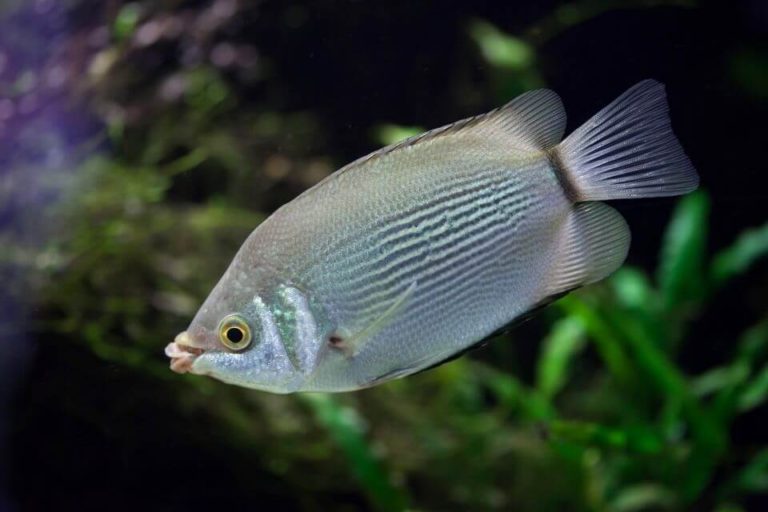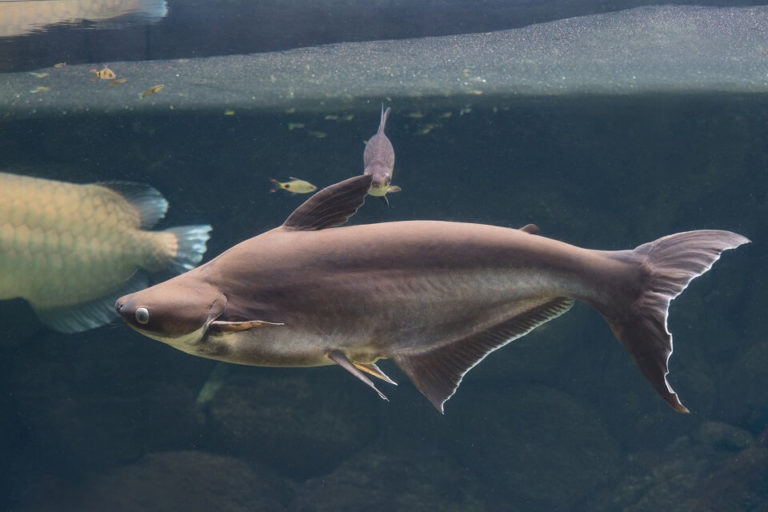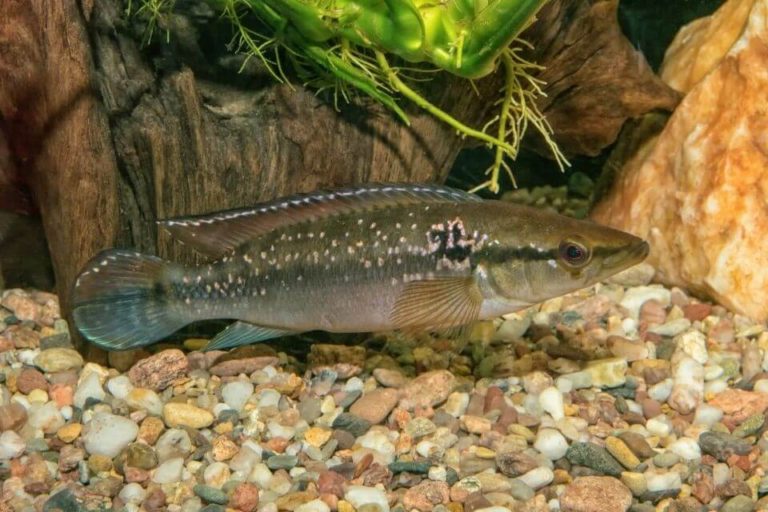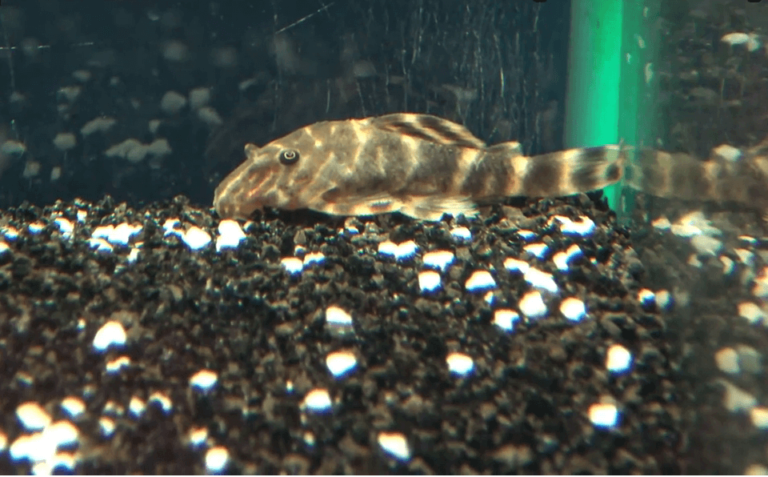Zebra Pleco Care Guide: Lifespan, Size, Food, TankMates, Breeding, More
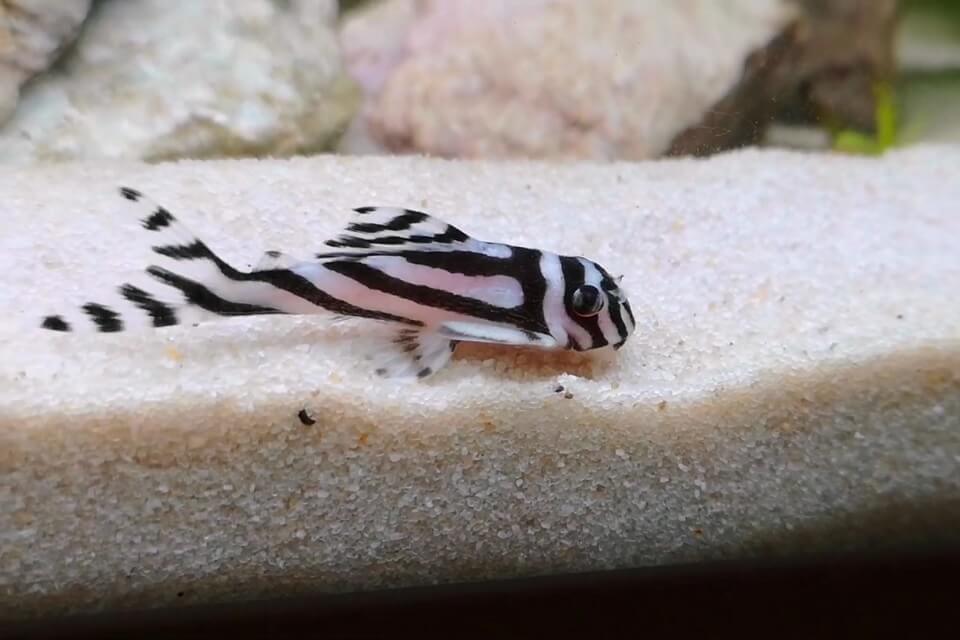
The Zebra Pleco is an easy-to-care, stunning, and distinctively looking freshwater aquarium fish species.
It is one of the most interesting suckermouth beauties and its remarkable white and black stripes make it a highly demanded fish by all kinds of aquarists and fish keepers.
The demand for this fish even surpasses what the pet or shops can offer and considering that the fish is deemed to be endangered in its source country, Brazil, it comes with a relatively higher price.
If you are lucky enough to find a Zebra Pleco in your pet store, then you must treat it like the real gem it is. Adding this fish to your community aquarium will definitely make a statement and you need to maintain this for long by taking good care of it.
This guide contains all the care guidelines you need to know about the Zebra Pleco. So if you are looking to keep this freshwater fish in your Aquarium, read through to understand what it calls for.
| Quick Facts: | |
|---|---|
| Common Names : | Zebra Pleco, Imperial Pleco, Zebrawels |
| Origin : | Xingu River in Brazil |
| Family : | Loricariidae |
| Scientific Name : | Hypancistrus Zebra |
| Care Level : | Moderate |
| Temperament : | Peaceful |
| Social : | Community fish |
| Diet : | Omnivores |
| Size (average) : | 3 - 4 inches long |
| Lifespan : | 10 - 15 years |
| Breeding : | Egg layer |
| Minimum Tank Size: | 30 gallons |
| Tank Environment : | Freshwater with fast current, Sandy and grave mixed substrate, Rocks with more hiding places, Fever aquarium plants |
| Temperature : | 79 – 88 °F (26 – 31 °C) |
| Water Hardness : | 2 - 6 dKH |
| Water pH Level : | 6.5 - 7.0 |
Overview of Zebra Pleco
Scientific name: Hypancistrus Zebra
Other alternative names: Imperial Pleco, Zebrawels
Zebra Pleco is a breed of catfish species that are native to the Xingu River in Brazil. This fish species is one of the most stunning, unique catfish breeds you can keep in a freshwater aquarium.
These Pleco species boast amazing white bodies with bold black stripes that make them look very attractive.
They are an endangered species in their natural habitats and because of this, they are a rare species that acquiring would cost $150 to $300 per fish in the US Aquarium market.
These fish will, however, offer way more with regards to looks, excellent behavior, and decent lifespan.
Zebra Pleco prefers tanks with plenty of hiding places as this assures them that when they come out to showcase their beauty, they will have somewhere to hide in case of any threats. Zebra Plecos prefer well-aerated waters with high currents.
Although Zebra Plecos are very well adapted to a wide variety of water conditions, they will still be affected by abrupt water changes or water that has accumulated a lot of waste.
If you replicate their natural habitats’ water conditions in the tank, you will not encounter significant problems keeping these fish.
Breeding the Zebra Pleco is not that complicated as spawning can occur even without major modifications in their tank conditions. The males are egg guarders and the eggs will take approximately one week to hatch.
The fry will take about 2 days to become free swimming and about 2 to 3 months to grow to 1 inch.
Zebra Pleco Size
A mature Zebra Pleco’s average size is 3 to 4 inches, a perfect size for a display aquarium. The growth rate depends on how well you keep the water parameters in the required conditions.
Keeping the water warm will, for example, increase the growth rate of these fish. The quality of food you give your Zebra Plecos will also contribute to their growth rate.
Zebra Pleco Lifespan
The lifespan of a Zebra Pleco is quite impressive. Many tank reared Zebra Plecos are known to live for 10 to 15 years. As a tank fish keeper, you should always understand that your fish’s lifespan will always depend on how you take care of them.
Zebra Pleco Typical Behavior
The Zebra Pleco is a shy, peaceful, and non-aggressive fish. The fish will live peacefully with other similarly behaved bottom-dwellers and also their own company.
Due to their shy and calm nature, they need to be fed in quiet places where they will be comfortable to feed.
Zebra Plecos are nocturnal, meaning that they are most active at night. With proper lighting, they can be in for an eye-catching thrill at night. Feeding these fish during the night or when the lights are off can also solve the feeding problems.
Note that being nocturnal does not mean that they are entirely neutral during the day. A Zebra pleco will still come out of their hiding places during the day when in spirit.
Zebra Pleco Colors and Appearance, and Special Markings
The Zebra Pleco is a medium-sized tank fish with a long body and a flat stomach. The fins are pretty standard, only that the dorsal fins tend to broaden, especially on reaching maturity.
The pectoral fins are also hairy and you will note this characteristic being more dominant in the male varieties. Its anal fin has one coarse and four soft rays.

The unique appearance features of this fish include an elongated head with highly placed eyes, a connection of the eyes and the mouth by lateral stripes, bluish eyes, a hooked pin on its premaxilla, and two pairs of small barbels.
Zebra Plecos have a small suckermouth with plenty of long teeth. The mandible has 7 or 8 long curved teeth that bifurcate to the edge, while the maxilla has 8 deeply bifurcated teeth.
Zebra Plecos have a stunning white body with striking black stripes. This color pattern makes them look very unique among other freshwater aquarium fish. Perhaps the color patterns are also where their name is derived from.
The color pattern of the Zebra Pleco is uniform throughout its body, from the head through the dorsal and pectoral fins to the tail.
In general, the stripes appear to be diagonal entirely, but if you look closely, you will notice that the stripes are more lateral on the head region and vertical as you move towards the pectoral and dorsal fins.
Note that the color pattern develops as early as the fry is free-swimming. The quality of the tank water and the food you give your Zebra Pleco will influence how fast the colors will develop fully.
Aquarium Care and Conditions
– Tank Conditions and Care
Zebra Plecos require water with strong currents and so you need to invest in a powerful water filter. The water should also be sufficiently aerated as the fish likes high oxygen saturation.
You can keep Zebra Plecos in a community tank to brighten it up or in a singly occupied tank to create a centerpiece in your home.
Keeping a Zebra Pleco in a group of its own companion is preferable as it will be easier to feed them. Even better, if you keep one male and several females in an aquarium, it can potentially turn to be a spawning tank.
While here, it is essential to mention that most health conditions that the Zebra Pleco develop are usually an indicator that there is something wrong with the tank conditions.
– Zebra Pleco Tank Size
A minimum tank size of 30 gallons is required for 4 to 5 Zebra Plecos. If you have a large group of these fish species, then you need a bigger tank. This also applies to a community tank.
Here, experts recommend that the bigger the tank for this fish species is, the more control you will have over the water parameters.
– Zebra Pleco Tank Setup
Since this fish is nocturnal, it prefers low light so it is recommendable to install a dim lighting system in the tank. Also, make sure that the lights are turned off during the night so that they comfortably come out to play.
For the substrate, a Zebra Pleco prefers a mixture of fine sand and river gravel. To imitate their natural environment, you can also add rocks and driftwood to their tank but make sure that they don’t take up much of their swimming space.
If more than one Zebra Plecos are kept in one freshwater aquarium, you can arrange rocks to form caves as this will support the territorial behavior they show to their own company.
Slate stones, snags, and various roots can also be included in the aquarium as decoration and to provide shelter.
– Suitable Plants
Considering the high water temperature that this fish requires (see the section below), you are limited to only plants that can withstand high temperatures. Also, note that this fish prefers decorations other than plants as this is what their natural habitats offer.
Here you would want plants that can also withstand high water currents, such as Vallisneria and Amazon Sword plants.
– Water Conditions and Parameters
For a Zebra Pleco to thrive in a freshwater tank, you need to maintain the following water conditions and parameters:
- Temperature: 79 °F – 88 °F (26 °C – 31 °C)
- pH: 6.5 – 7.0
- Hardness: 2 – 6 dKH
Other than the filtration discussed above, the fish also needs water renewal (20 to 25%) weekly. This ensures that the water is clean and of the required quality at all times. Please note that abrupt changes can be detrimental to your fish and should be avoided at all costs.

Diet and Feeding For Zebra Pleco
Zebra Plecos are omnivores and can survive on absolutely any type of good quality food. They prefer live and frozen food, but live foods are dearer to them.
Anything from blood worms, brine shrimp, and sliced veggies to crushed peas and algae wafers, you are not limited to what you can feed them.
Like other Loricariidae breeds, Zebra Plecos enjoy lettuce, cucumber, and squash slices and it is recommended to include them in their diet. The fish will also do just fine with all high-quality, properly sliced, commercial dry feeds.
As mentioned above, a Zebra Pleco is not the kind of fish that will gobble or fight with other fish for the same. Whether this is due to their shy behavior or low appetite, you should find a way to ensure that they get enough food at all times.
If they are in a community tank, it would be recommendable to place their food in a quiet place where they will feel comfortable and unthreatened to feed on. The place they like hiding would be a perfect spot.
Please keep food gobblers out of the tank that you have kept in your Zebra Plecos. To respond to their nocturnal nature, it would be best to feed them when the lights are off.
Zebra Pleco Common Diseases
Although the Zebra Pleco is a relatively hardy and healthy fish, it will still be affected by fungal, bacterial, and parasitic conditions that affect other freshwater aquarium fish.
These ailments, of course, arise when the water conditions and food are not kept to the required standards.
Do the water changes as advised above and treat your water with anti-bacterial when the water quality deteriorates.
Always monitor the fish carefully and immediately treat them with appropriate medications only if you are able to identify the disease correctly.
If you are not sure about the disease then consult your nearest veterinarian when you notice weird changes in your fish’s mental and physical conditions.
Zebra Pleco Gender Differences
There are no major sexing parameters for this fish but you can rely on the following to tell the male and female apart:
- At the reproductive stage, the male has a more prominent and broader head than the female.
- The female is generally smaller than the male but will appear rounder, especially when carrying eggs.
- The first rays of pectoral fins for the males are thicker than that of the females.
- Unlike females, males have a spiny projection on the rays during the reproductive period.
Zebra Pleco Breeding
Fortunately, the pricey Zebra Pleco is not hard to breed and you can easily expand your stock if you follow some simple practices.
First, it is good to note that the fish can spawn right in the tank where they live as long as they are of age, in the required group size and male-to-female ratio.
A Zebra Pleco will be ready to reproduce when 2 to 4 years old. The right group size to keep them is 5 to 6 individuals with a ratio of at least 1 male for 3 females.
Depending on the male’s experience, several females can spawn at the same time with one male.
In the breeding tank, it is crucial that you include many shelters, and for this, you can even have a tube that the breeders can easily fit in. The water temperature should still be high and should never be below 77 °F (25 °C).
Water temperature influences several things in the breeding tank. The rate at which the eggs develop, for example, depends on how the water is heated. The water temperature also affects how fast the juveniles grow.
The warmer the tank, the better for the Zebra Pleco. Don’t forget to increase aeration in the breeding tank to accommodate the young ones.
The number of eggs that the females lay on successful mating depends on age, or again, experience. Young, first-time females will lay 5 to 6 eggs while experienced and more mature females will lay up to 25 eggs.
When the female lays the eggs, it will be the male’s duty to guard them until they hatch. The eggs take one week to hatch, 2 days for the fry to become free-swimming, and 2 to 3 months to grow to 1 inch.

Zebra Pleco Tank Mates
The Zebra Pleco is a peaceful, completely laid-back fish that will live in harmony with other tank fish of similar behavior. Even with this, the Zebra Pleco is not the best fish to add to a community tank and there are reasons for that.
First, the water temperature they require is relatively high than what a standard freshwater aquarium fish would call for. Also, the fish requires strong flowing water, which may disturb other fish that require smooth and calm water.
The other reason is their shy feeding behavior which, if kept with food gobblers, may starve them.
If you wish to overrule all these requirements, then you can keep this fish with any other non-aggressive, similar-sized fish in a tank aquarium.
If you want to keep your Plecos happy and comfortable at all times, just keep them with their own companion in groups of 5 to 6. A tank with one male and say, three females would work excellently for these fish.
A few recommended Zebra Pleco Tank Mates are:
- Guppy species
- Chili Rasbora
- Otocinclus Catfish
- Cherry Shrimp
- Platy fish
- Serpae Tetra
- Black Skirt Tetra
- Cardinal Tetra
- Denison Barbs
- Harlequin Rasbora
- Cockatoo Dwarf Cichlid
- Black Phantom Tetra
Origin, Distribution, and Availability
The Zebra Pleco originated from the Xingu River in Brazil, a southeast tributary of the Amazon River. In their native environment, these fish species live in deep water channels, particularly in places with alternating sandy and rocky sections.
The bottom of this wider river is mostly plantless and has fast-flowing water that keeps the environment adequately aerated. If you plan to keep Zebra Pleco in your home aquarium, then these conditions should be replicated in the tank you want to keep them.
Initially, the river boasted high current waters that this fish perfectly thrived in. When human activities of constructing power generation dams kicked in, the water flow reduced and so was the number of Zebra Plecos.
It even reached a point that the Brazilian government listed this fish as endangered and banned its export.
Only a few of the Zebra Plecos that made it to the international markets are continually bred to try and meet their high demand. The good thing is that breeding this fish is not very complicated and slow, the supply gap that is in the market will soon be filled.
Currently, private breeders sell one Zebra Pleco for $125 – $300, while in online pet stores, the price averages at $200+. Expect the price to fall in the near future.
Frequently Asked Questions
– How Big Do Zebra Plecos Get?
A Zebra Pleco grows up to 3 to 4 inches when kept in proper tank conditions. Although these fish grow very fast to reach this size, they take a longer time to reach maturity or reproductive age.
– How Long Does It Take for A Pleco to Grow to Full Size?
Most Zebra Plecos will grow to full size (3 to 4 inches) in their first year. This, of course, depends on how well you feed them and maintain their tank conditions. Sometimes this time frame will extend up to 2 to 3 years.
These fish will spend the rest of their years developing their colors and body markings, but the size will remain at this range. The reproductive age can be somewhere between 2 to 4 years.
– Are Zebra Plecos Hard to Keep?
Zebra Plecos are not hard to keep as they are generally hardy and healthy. Give them quality food in enough amounts and when they are most active and ensure that the water quality does not deteriorate.
To make them even happier and satisfied, provide at least 6 gallons of tank size for each Zebra Pleco you keep in your tank. Don’t forget to add a lot of shelter to their tanks, as this also improves their quality of life significantly.
– How Do You Tell If A Zebra Pleco Is Male or Female?
The male’s head is broader than that of the females, but that of the females is rounder. The other significant differences are on the pectoral fins. The males have thicker hairs on the pectoral fins than the females.
Additionally, the male’s first pectoral-fin rays are thicker than what you will see on a female variety. In spawning conditions, the males also develop a spiny projection on the rays.
– Are Zebra Plecos Aggressive?
Zebra Plecos are not aggressive and show shy and calm behavior. They live peacefully with their own companions or compatible tank mates. They can show territorial behavior when kept with their companions in the same tank.
– Can a Pleco Eat Other Fish?
According to reports from seasoned fish keepers, Plecos will only eat dead fish that they may find on the bottom of the tank and hence you should not worry that it will snack on your other aquarium fish.
You should constantly monitor your aquarium to ensure that there are no dying or dead fish at the bottom of the tank.
– Can You Put 2 Plecos in The Same Tank?
Yes, of course, we can keep 2 Zibra Plecos or more in the same tank if the male to female ratio is compatible and the tank size is more spacious. The best practice is to keep one male fish with 3 female Plecos in a tank.
You can increase the number of Zebra Plecos by maintaining the above ratio in a larger tank. Make sure you provide more hiding places if you accommodate more plecos in a single tank.
– What is The Rarest Pleco?
The Typhoon Pleco is the rarest pleco and can cost you a lot more to purchase. These Typhoons are fairly large and their beauty is something that will easily win your heart. The money you will spend on this pleco is undoubtedly worth it.
– Will Plecos Kill Each Other?
Rarely will Plecos do this, but when they are kept in stressful conditions and in pairs, they may hurt and fight each other to the point of death. Even the stress and fear they instill in each other can eventually lead to death.
– Why Are Zebra Plecos So Expensive?
The primary reason why Zebra Plecos are so pricey is that they are not allowed to be exported from their source country, Brazil.
The few that were already in the market before the ban (happened in 2004) are the ones that are constantly bred and since the demand is high, the price is not just the normal rates you will acquire other freshwater aquarium fish at.

Final Thoughts
The Zebra Pleco is a rare fish and definitely not the cheapest fish you will find on the market. Going the extra mile in terms of care will ensure that you will get value for your money.
Furthermore, the Zebra Plecos are good-looking and impressively behaved, and caring for them is the only way you can pay back what they offer.
Provide the proper care, the Zebra Plecos can stay in your aquarium longer than most of the fish you keep. As long as the water is clean and in the right parameters, infections will be kept at bay and this fish will be healthier and always ready to make an eye-catching beauty statement.
You can also maintain a good number of them if you master the breeding procedure provided in this guide.
A Zebra Pleco is a beautiful addition to a freshwater aquarium and we highly recommend it. Hope this guide provided comprehensively all the information you needed to know about the Zebra Pleco. All the best as you keep it.


